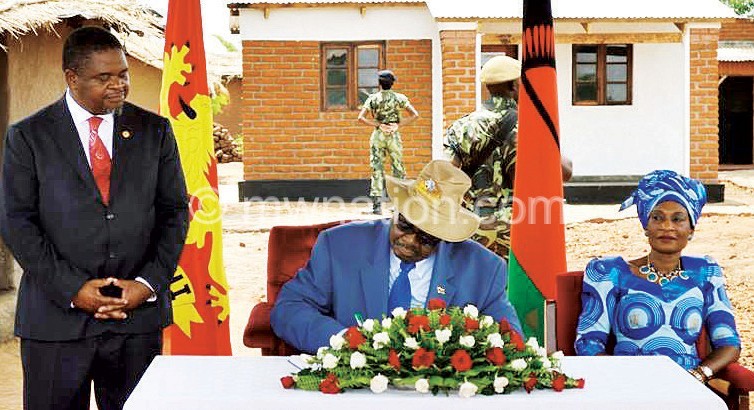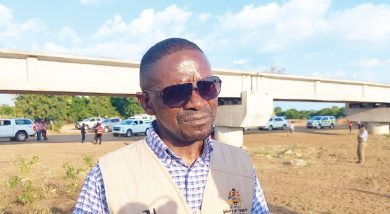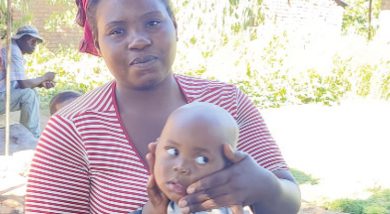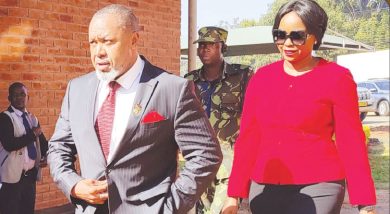APM presses panic button
President Peter Mutharika promised to help the poor to build 66 000 houses within five years, from 2014.
But with six months to the target date—and the next election—the administration has only erected 26 000 houses, according to information from the Ministry of Lands, Housing and Urban Development.

In fact, as of end September 2018, 12 councils, out of 28, have no house from the second phase that is completed, yet government has decided to move to the third phase; stalking anger among local leaders.
This progress is just 39 percent of the 66 000-house promise Mutharika made under the Decent and Affordable Housing Subsidy Programme (DAHSP) to achieve between 2014 and 2019.

With failure staring in the face—and the political price Mutharika and his Democratic Progressive Party (DPP) could pay for it at the polls—panic has set in.
In a race against time, Capital Hill has sent an all-out alert to council officials to double the annual number of houses per constituency from 75 to 150 in the third phase, even as phase two’s completion rate stands at just 18.6 percent on average.
In an October 4 2018 memo to councils, that Weekend Nation has seen, chief housing officer in the Ministry of Lands, Housing and Urban Development Esau Mwambira urges local authorities to expedite the programme to catch up on lost time.
Said Mwambira: “Instead of 75 households benefiting per constituency, as per project plan, 150 houses will now be constructed.”
But if the programme could only manage 26 000 houses in more than four years, how can it support the building of 40 000 units in six months?
And if in four years, the programme could only absorb K19.4 billion or 49 percent of the programme’s approved budget of K39.4 billion over five years, how can it spend K10 billion in half a year, which is the initiative’s budget for this financial year?
Vintulla is upbeat though
In a follow up interview yesterday, the ministry’s spokesperson Charles Vintulla said the problem all along has been inadequate funding; hence, he said, the remaining 40 000 houses can be built within the next six months if the ministry is given money in time.
“The houses constructed so far are in respect of funds that were actually disbursed to the Ministry. Funds permitting, we could have completed constructing all the houses,” he said.
But this confidence is not reflective of challenges the programme faces, especially when the second phase has achieved so little.
As at September 30 2018 the completion rate for the second phase of the programme-supported houses in the North stood at zero percent; 11 percent for the Centre, 44 percent for the South and 18.7 percent for the Eastern Region.
This gives an average completion rate for all the houses in the country of 18.6 percent in the second phase, according to the ministry’s progress report.
Of the houses constructed so far, 15 350 are new while 11 000 are improvements of existing units, according to Vintulla.
The slow pace of implementation is stalking anger, with some council officers, traditional leaders and legislators expressing frustration, especially those from the Central Region districts of Mchinji, Nkhotakota, Dowa and Ntchisi where the initiative has reached out to the least number of beneficiaries, some not at all.
Random interviews with district rural housing officers in the four districts, where prospective beneficiaries have been on the waiting list since 2015, are not amused with the lack of progress.
One officer, speaking on condition of anonymity, explained that the prospective beneficiaries are angry with government’s decision to proceed to phase three in some districts in the Southern Region when some beneficiaries earmarked for phase one in the Centre have not received anything.
Said the officer: “Chiefs and the prospective beneficiaries are angry. The problem is that beneficiaries are aware of developments in other districts, and convincing them about what government is telling us is very difficult.”
Another officer said: “Many are reacting angrily and they think I am lying.”
In a telephone interview yesterday, group village head Chimteka of Mchinji observed that most people in his area lost trust in the programme.
Said the chief: “The last time people received materials was in 2016 and people are now starting to believe that the Malata and Cement subsidy programme was temporary.”
Nkhotakota South East legislator Everson Makuwa Mwale said he was one of the MPs who have been pushing in Parliament to phase out the programme on grounds of poor implementation.
On his part, lawmaker for Mchinji North East Alex Chitete wants the ministry to intervene so that the programme in his area can progress to phase two and three.
Mwambira confirmed the disparities in implementation levels across districts, but explained that government plans to combine implementation of phases one and two in those districts that are behind.
He blamed the delay in rolling out the programme in the four districts on poor monitoring as well as on suppliers of materials, some whom he said prefer to deliver only to councils that are near them.
He said from now onwards, the ministry will intensify monitoring to ensure that no council is left behind.
Mwambira said this year, the Southern Region was prioritised because of the country’s rainfall pattern as rains start in the South, but vowed that his ministry would ensure consistency this time around.
“For the sake of consistency, we will make sure that the same suppliers provide materials to the same council for phases two and three.”
In his October 4 2018 memo, Mwambira wrote: “The monitoring and evaluation exercise the ministry undertook recently shows that a number of houses in the first and second phases are not yet completed.
The initiative is one of President Mutharika’s pet programmes alongside construction of community colleges, several roads across the country, five universities, and the revival of the Shire Water Way Project aimed at reducing transport costs for Malawi’s imports and exports.
The housing programme is designed to construct 75 houses per constituency per year—70 on a 50 percent subsidy and five on grants—translating to 66 000 houses for all the 193 constituencies in five years, according to the initiative’s concept note.
It was meant to benefit poor people in the villages by giving them material loans to acquire a maximum of 30 ten feet 29/30 gauge corrugated iron sheets and a maximum of 30 bags 50 kg bags of cement and other related building materials, according to the concept note.
According to the concept note, village and area development committees are supposed to identify the beneficiaries. The project is implemented through local councils and coordinated by the Ministry of Lands, Housing and Urban Development at national. n





